June 16, 2025 | 06:34 GMT +7
June 16, 2025 | 06:34 GMT +7
Hotline: 0913.378.918
June 16, 2025 | 06:34 GMT +7
Hotline: 0913.378.918
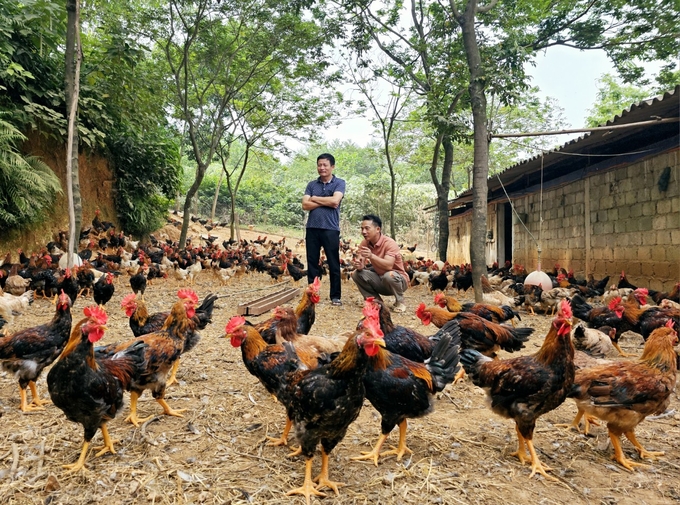
A biosafety livestock production revolution is happening in Vinh Phuc. Photo: Hoang Anh.
Finding strengths in tourism and agricultural development, many years ago, chicken farming has become a spearhead economy in many localities in Tam Dao district. Phung Thi Vi, Head of Tam Dao District Office of Livestock Production and Animal Health, called Tam Quan commune the "heart" of livestock farming in this district.
If the entire Tam Dao district regularly maintains a total herd of 1.6 - 1.7 million chickens, Tam Quan alone has 1.3 - 1.4 million chickens every year. Statistics show that the entire commune has approximately 1,700 chicken farming households, which includes more than 150 farm-scale models. Particularly in recent years, thanks to well-implement biosafety livestock farming measures, chicken farmers of Tam Dao district in general and Tam Quan commune in particular are no longer afraid of disease.

Tam Quan commune is famous for its chicken farming industry. Photo: Hoang Anh.
There was a time when almost everyone in Tam Quan commune raised chickens, from small-scale farms and cooperatives to establishing production and processing linkages with large corporations. Talking about chicken farming in Vinh Phuc province meant talking about Tam Quan commune and vice versa.
For a long time, chicken farming was spontaneous without any attention to quality control of breeds, feed, and vaccines, so livestock farmers in Tam Quan commune were struggling because of epidemics. Many families even went bankrupt because of chickens. However, from 2015 onward, thanks to changing mindsets and applying new farming solutions specifically biosafety processes, many families in Tam Quan have turned their lives around and become billionaires.

Nguyen Duy Hien (right), owner of the largest chicken farm in Lang Ma village. Photo: Hoang Anh.
During the peak period, the 1,000 m2 barn of the family of Nguyen Duy Hien and Nguyen Thi Thanh Loan in Lang Ma village (Tam Quan commune) raises 13,000 - 15,000 chickens. In recent years, Hien's family has raised approximately 25,000 chickens per year on average.
Due to the impact of high animal feed prices and low chicken prices, from the beginning of the year to the end of August, Hien's family lost VND 15-20 million each month, but chicken prices are currently VND 70,000 - 90,000/kg depending on the type, so the family is expecting a profit of VND 40 - 50 million /1,000 chickens. If there is no problem from now until Tet, Hien's chicken farm can make VND 500 - 700 million in profit.
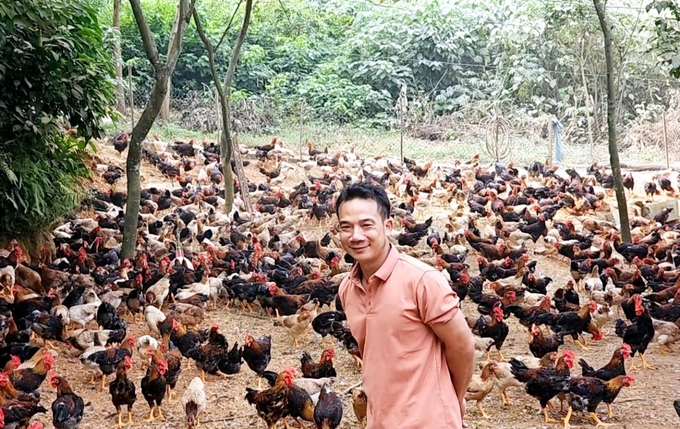
"Chicken farming’s main concerns at the moment are input and output prices. We do not need to worry about diseases because the people pay great attention to biosafety farming measures," said Hien. Photo: Hoang Anh.
Being a bold and dynamic farmer, Hien pioneers in converting to the biosafety chicken farming model in Tam Quan commune. On their hilly land, the couple invested and built two closed barns, with automatic feeding and drinking troughs plus a cooling system.
The family has certain ways to minimize risks and maintain high incomes. The first solution is vaccination. Hien's family normally vaccinates the batch of chickens while following the recommendations of the local veterinary officer. The next step is to clean the barn and disinfect livestock areas, transportation vehicles, food, drinking water, etc.
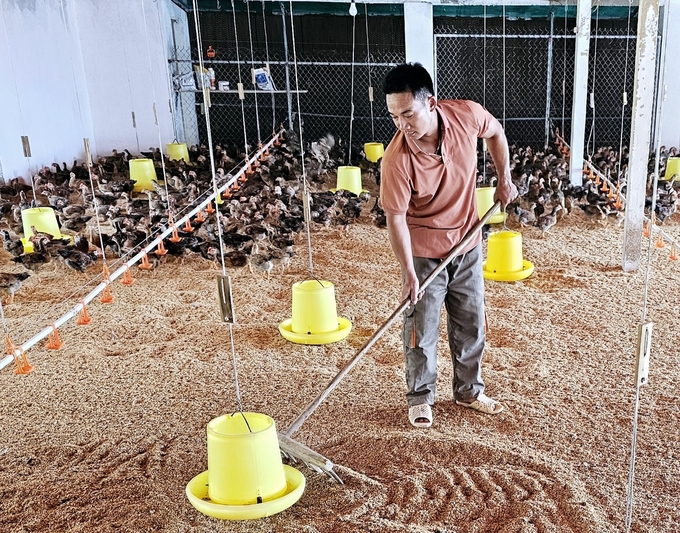
Hien is also the first person in Tam Quan commune to use microbial products as bedding to handle environmental problems. Photo: Hoang Anh.
Tran Van Diep, Tam Quan Commune Office of Livestock Production and Animal Health, said, ”Now almost all farming models with a scale of 1,000 chickens or more use biosafety farming methods and use microbial products as bedding. This is the basis for Tam Quan the “chicken capital” to aim for sustainable chicken production chain and build the “Tam Dao Chicken” brand.
Vinh Phuc province and Tam Dao district have support policies for livestock households to register for VietGAP and OCOP certification, establishing cooperatives and cooperative groups to increase value for livestock farmers in the area. Chicken farming in Tam Quan commune is experiencing a transition in both scale and quality.
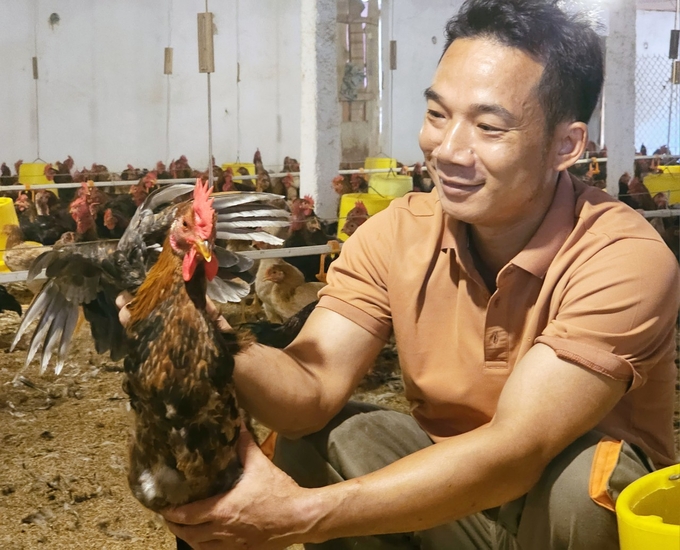
Tam Dao commune aspires to build the “Tam Dao Chicken” brand. Photo: Hoang Anh.
Le Xuan Cong, Director of Vinh Phuc Department of Livestock Production and Animal Health, said that Vinh Phuc’s livestock development scheme for the period 2022 - 2025 identifies 3 main types of livestock: cows, pigs and chickens, and the total chicken herd has now exceeded 12.5 million, guaranteeing the set target.
As a result, the province’s main objective is not to expand the herd but instead focus on biosafety measures, addressing environmental issues while improving economic efficiency in local farming models.
Implementing the plan of Vinh Phuc People's Committee on reducing environmental pollution in livestock farming by using biological products in the 2021 - 2023 period, the provincial agricultural sector has supported 50% of the cost of purchasing biological products to make bedding and treating chicken waste. “Biosafety chicken farming models have proven its economical, environmental and social efficiency. This is surely the direction of Vinh Phuc’s animal husbandry industry in the years to come,” said Le Xuan Cong.
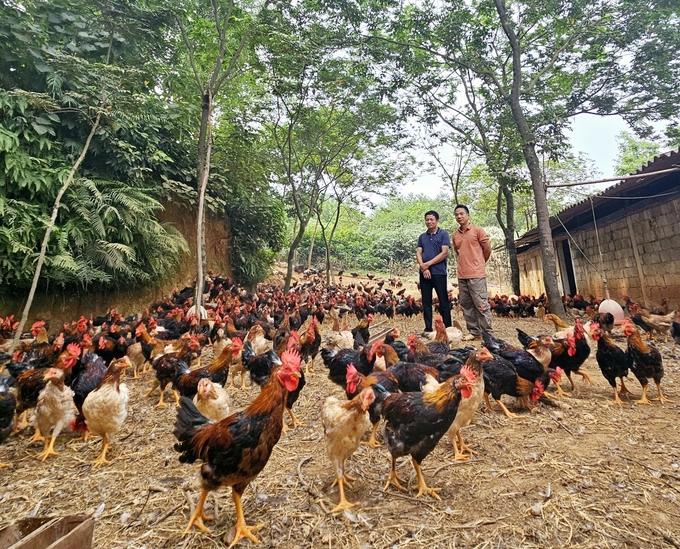
Vinh Phuc aims for a sustainable direction in chicken farming. Photo: Hoang Anh.
The most obvious effect of biosafety livestock farming is that it solves environmental inadequacies caused by livestock farming activities. The support program to reduce environmental pollution in livestock farming by using biological products has helped organizations and individuals become more aware of ensuring hygiene in animal husbandry.
Translated by Samuel Pham
![Turning wind and rain into action: [4] Bringing climate bulletins to remote and isolated areas](https://t.ex-cdn.com/nongnghiepmoitruong.vn/608w/files/linhnhp/2025/06/14/1152-z6704423696987_15fd32ffc26d590d204d520c9dac6786-nongnghiep-151141.jpg)
(VAN) The Vietnam Agriculture and Nature Newspaper interviewed Mr. Vu Thai Truong, Acting Head of Climate Change and Environment at UNDP Vietnam, to gain deeper insight into how climate bulletins are delivered to farmers.

(VAN) In Tien Giang, a high-tech shrimp farm has developed a distinctive energy-saving farming model that has yielded promising results.
![Turning wind and rain into action: [3] 300.000 farmers benefit from agro-climatic bulletins](https://t.ex-cdn.com/nongnghiepmoitruong.vn/608w/files/news/2025/06/12/e5a48259d6a262fc3bb3-nongnghiep-125122.jpg)
(VAN) The agro-climatic bulletin has become a valuable tool for farmers in the Mekong Delta. After more than five years of implementation, the initiative is gradually being expanded nationwide.
![Turning wind and rain into action: [2] Providing forecasts to the people](https://t.ex-cdn.com/nongnghiepmoitruong.vn/608w/files/news/2025/06/12/e5a48259d6a262fc3bb3-nongnghiep-103927.jpg)
(VAN) In addition to improving the quality of hydrometeorological forecasts, putting forecast bulletins into practical use is crucial for production and disaster prevention.

(VAN) Blue carbon is receiving attention for its rapid absorption capacity and vast potential. It represents a promising nature-based solution to respond to climate change.
/2025/06/11/3507-1-161904_583.jpg)
(VAN) Seagrass beds and coral reefs serve as 'cradles' that nurture life in the ocean depths, creating rich aquatic resources in Vietnamese waters.
![Turning wind and rain into action: [1] Forecasting for farmers](https://t.ex-cdn.com/nongnghiepmoitruong.vn/608w/files/news/2025/06/11/e5a48259d6a262fc3bb3-nongnghiep-111919.jpg)
(VAN) Weather is no longer just a matter of fate. Forecasts have now become an essential companion for farmers in every crop season.